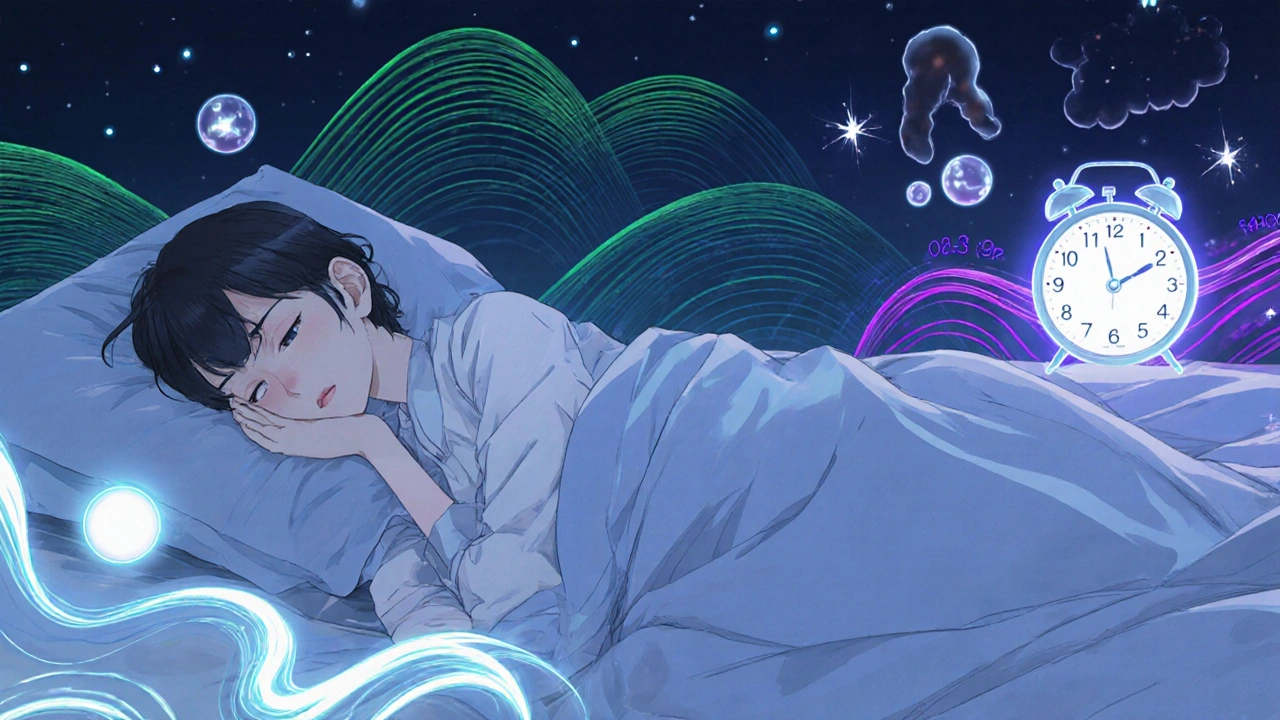When it comes to treating treatment‑resistant schizophrenia, Clozapine is an atypical antipsychotic known for its efficacy but also for a distinct side‑effect profile. One of the less‑talked‑about areas is how it interacts with sleep - a factor that can dramatically affect overall recovery. Below we break down the science, the real‑world experience, and practical steps to keep your nights as restful as possible.
How Clozapine Works in the Brain
Clozapine blocks dopamine D2 receptors less aggressively than older drugs, while hitting serotonin 5‑HT2A, histamine H1, and muscarinic receptors. This broad receptor footprint explains both its superior control of psychotic symptoms and its propensity to cause sedation, weight gain, and metabolic changes. The histamine H1 antagonism is the primary driver of the drug’s sleepy feeling, especially during the first weeks of therapy.
Clozapine’s Direct Effects on Sleep Stages
Polysomnography studies on patients taking clozapine show three consistent patterns:
- Increased total sleep time - many users report falling asleep faster and staying asleep longer.
- Reduced REM latency - REM sleep often begins earlier, but the overall REM proportion can be slightly lower.
- Higher proportion of slow‑wave sleep (stage 3) - deep, restorative sleep tends to expand, which many patients describe as feeling “more refreshed”.
These changes can be a double‑edged sword. While deeper sleep sounds good, the shift in REM can exacerbate vivid dreams or nightmares for some individuals.
Common Sleep‑Related Side Effects
Not every patient experiences the same sleep picture. Below are the most frequently reported issues:
- Excessive daytime sedation - the H1 blockade can linger into daytime, making concentration difficult.
- Insomnia after dose‑adjustments - paradoxically, when the dose is reduced, rebound wakefulness may appear.
- Restless leg‑like sensations - linked to the drug’s dopaminergic effects.
- Weight‑related breathing problems - rapid weight gain can trigger obstructive sleep apnea.
Because clozapine also carries a risk of agranulocytosis, clinicians must monitor blood counts regularly, which can add stress and indirectly affect sleep quality.

Managing Sleep Issues While on Clozapine
Here’s a step‑by‑step approach you can use in collaboration with your prescriber:
- Timing the dose: Take the larger portion of the daily dose in the early evening (e.g., 6 pm). A smaller morning dose can reduce daytime drowsiness.
- Sleep hygiene: Keep the bedroom dark, cool, and screen‑free for at least an hour before bed. Even a 30‑minute wind‑down routine can balance the drug’s sedative push.
- Physical activity: Light exercise (walking, yoga) after dinner helps regulate the deep‑sleep boost without overstimulating the nervous system.
- Review co‑medications: Antihistamines, benzodiazepines, or certain antidepressants can compound sedation. Discuss any over‑the‑counter sleep aids with your doctor.
- Address metabolic side effects: A balanced diet and regular cardio reduce weight gain, lowering the chance of sleep‑disordered breathing.
- Monitor with polysomnography if needed: A sleep study can pinpoint apnea or REM‑behavior issues that may require CPAP or medication tweaks.
When adjustments aren’t enough, clinicians sometimes add a low‑dose stimulant (e.g., modafinil) taken in the mid‑morning to combat daytime sleepiness. This should be a last resort, as stimulants can interfere with the drug’s benefits.
Comparing Clozapine to Other Antipsychotics on Sleep
| Antipsychotic | Sedation (H1 Block) | REM Suppression | Weight Impact | Agranulocytosis Risk |
|---|---|---|---|---|
| Clozapine | High | Moderate ↓ | Significant ↑ | Yes (rare but serious) |
| Olanzapine | High | Low ↓ | High ↑ | No |
| Risperidone | Low | Moderate ↓ | Moderate ↑ | No |
| Haloperidol | Low | Minimal | Low | No |
Notice how clozapine’s high sedation score correlates with the deep‑sleep boost, while its REM suppression is less aggressive than many alternatives. This makes it a unique choice for patients who already struggle with fragmented sleep.

Practical Tips for Patients and Clinicians
Both sides can take concrete actions to improve outcomes:
- Patient diaries: Log bedtime, wake time, medication timing, and any night‑time awakenings. Patterns often emerge that guide dose tweaks.
- Regular blood work: Keeping the agranulocytosis monitoring schedule on schedule reduces anxiety, a hidden sleep disruptor.
- Shared decision‑making: Discuss the trade‑off between superior psychosis control and potential sleep changes before starting therapy.
- Educate caregivers: Family members can help enforce consistent bedtime routines and watch for signs of daytime somnolence.
When sleep issues persist despite these measures, a short trial of melatonin (1‑3 mg, 30 minutes before bed) has shown modest benefit without interacting with clozapine’s metabolism.
Frequently Asked Questions
Does clozapine cause insomnia?
Insomnia is less common than sedation, but it can appear when the dose is lowered or if the medication is taken too early in the day. Adjusting the timing and adding good sleep hygiene usually resolves it.
Will clozapine improve my overall sleep quality?
Many patients report longer, deeper sleep because of the drug’s antihistamine effect. However, the benefit varies; some experience fragmented REM or vivid dreams that feel unsettling.
How can I reduce daytime sleepiness?
Take the larger dose in the evening, limit caffeine after noon, and keep a consistent wake‑up time. If daytime drowsiness remains severe, discuss a possible low‑dose stimulant or a slight dose reduction with your psychiatrist.
Does weight gain from clozapine affect sleep?
Yes. Rapid weight gain can lead to obstructive sleep apnea, which disrupts breathing and reduces oxygen saturation during the night. Regular weight monitoring and a balanced diet are essential.
Is melatonin safe with clozapine?
Melatonin does not interfere with clozapine’s metabolism and is commonly used to aid onset of sleep. Start with a low dose (1 mg) and monitor for any unusual daytime sleepiness.
Understanding how clozapine reshapes sleep can turn a potential side effect into a therapeutic advantage. By tracking patterns, adjusting timing, and addressing metabolic health, patients can enjoy both stable mental health and restorative nights.


Lisa Woodcock
October 25, 2025 AT 14:19Many of us who've been on clozapine notice the way it can turn a restless night into a surprisingly deep slumber. The histamine blockade is the main driver, so the drug naturally nudges you toward more slow‑wave sleep. That can be a blessing for people who struggled with fragmented rest, but it also means REM cycles shift earlier, sometimes leading to vivid dreams. If you find yourself waking up feeling refreshed yet still a bit foggy, consider tweaking the dosing schedule – an early evening bulk followed by a lighter morning dose often helps. Also, keep a simple sleep diary; tracking bedtime, wake time, and any nighttime awakenings can reveal patterns you can discuss with your psychiatrist.
Sarah Keller
November 8, 2025 AT 07:07Timing the dose is absolutely crucial – taking the larger chunk at 6 pm aligns the sedative peak with your natural circadian dip, cutting down daytime somnolence. Pair that with disciplined sleep hygiene: dim lights, no screens an hour before bed, and a brief wind‑down routine to harness the drug’s sleep‑push without overshooting. When you combine these strategies with regular cardio and a balanced diet, you also fend off the weight gain that can precipitate sleep‑apnea. If after these adjustments you still feel like a zombie during the day, bring up a low‑dose stimulant such as modafinil with your prescriber – but only as a last resort.
Veronica Appleton
November 21, 2025 AT 23:55Works well but watch the morning dose.
Zaria Williams
December 5, 2025 AT 16:43i rly felt the deep sleep boost when i started, like i could finally sleep through the night without constantly checking the clock. but the vivid dreams were kinda crazy, i’d wake up scared sometimes. also the weight gain part is no joke – i put on a solid 20 pounds in a few months and my doctor said we should check for sleep apnea. so yeah, clozapine can be a double‑edged sword if you don’t keep an eye on the side effects.